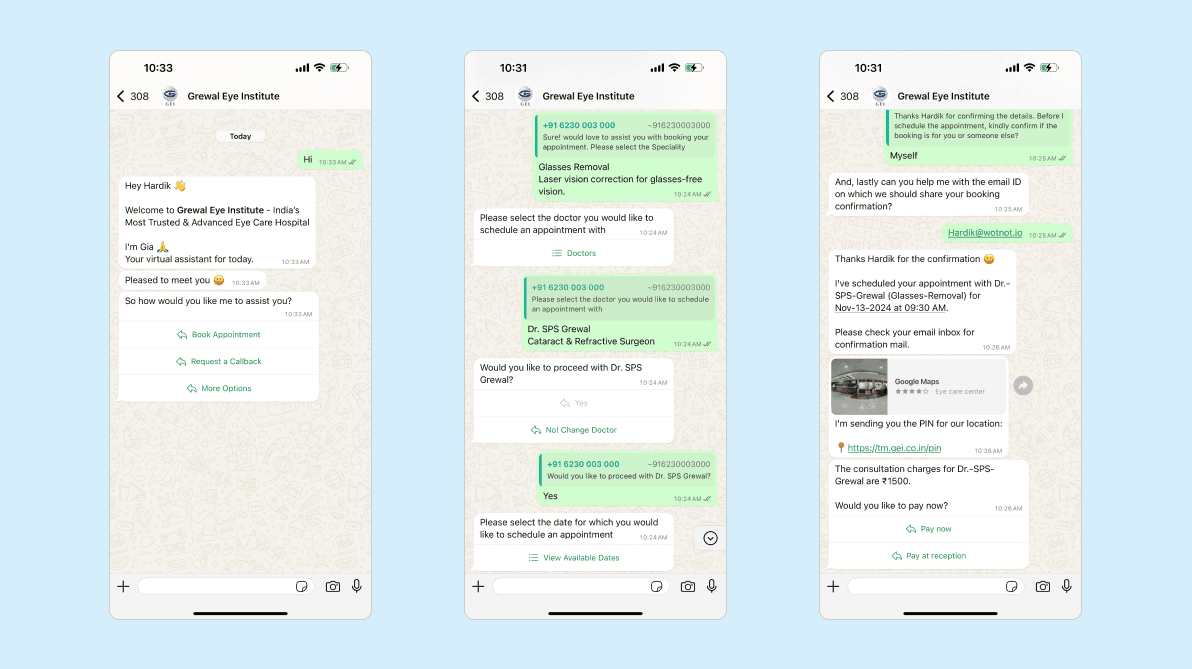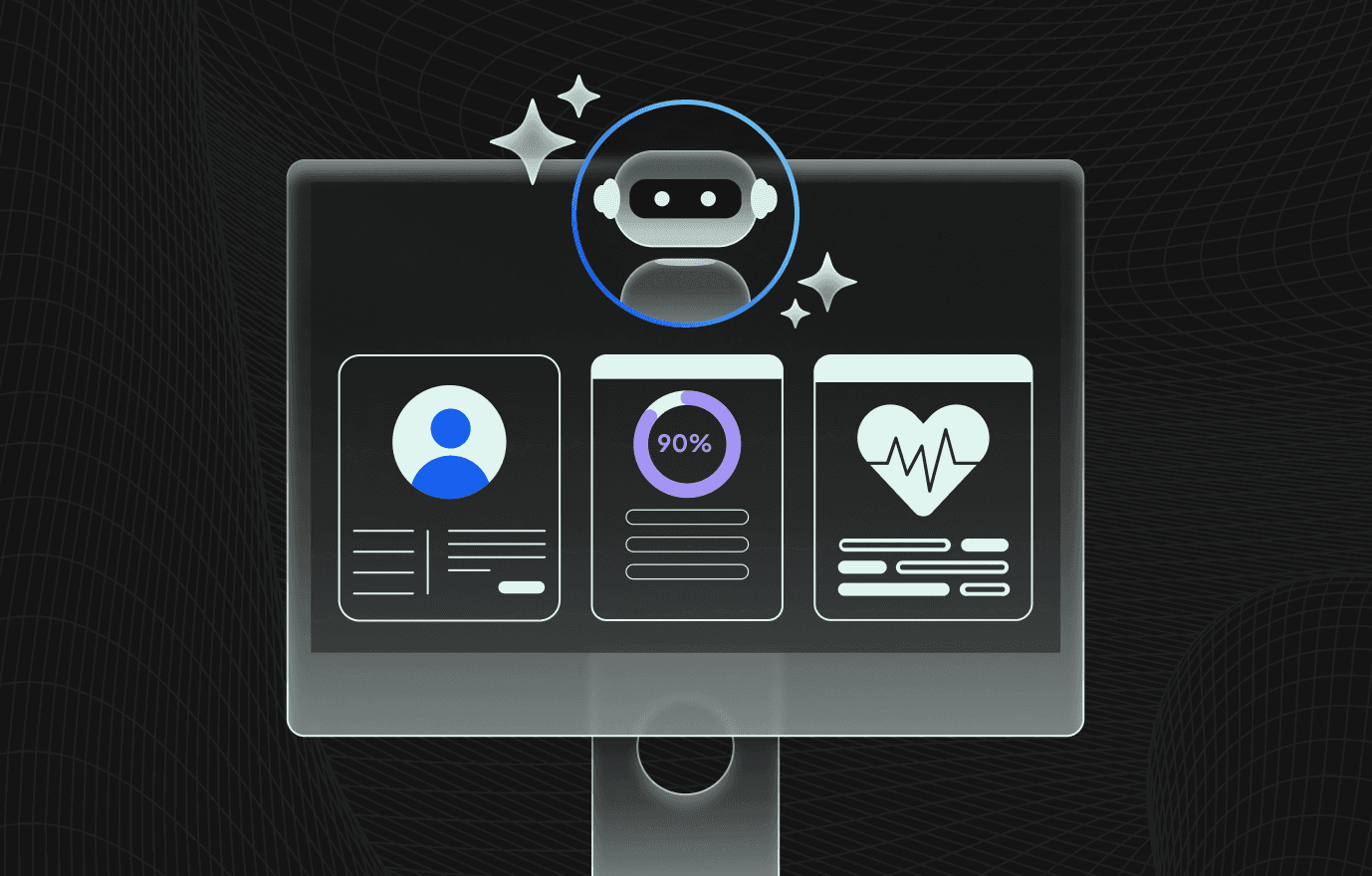Chatbot /
10 Min read
5 Important Healthcare Chatbot Use Cases in 2025
April 25, 2025
Hardik Makadia
Co-founder & CEO, WotNot
Healthcare is changing and fast.
Thanks to Artificial Intelligence, the healthcare chatbot is becoming a go-to tool for delivering 24/7, scalable healthcare assistance. From answering patient questions to streamlining operations, chatbots are making care smarter and more accessible.
With patients expecting 24/7 availability and personalized experiences, the need for an intelligent healthcare chatbot solution has never been greater. In fact, about 42% of healthcare institutions in North America expect an increase in chatbots for patient treatment by 2031.
In this blog, we’ll explore five impactful use cases of healthcare chatbots in 2025—from symptom checkers to post-treatment follow-ups—showcasing how they are improving patient engagement, assisting healthcare providers, streamlining operations, and enhancing overall care delivery.
Chatbots in healthcare are doing more than just answering questions. We all have seen them transform the way healthcare providers connect with patients. Powered by machine learning in healthcare, they’re automating key touchpoints and offering real-time support, driving better patient engagement across the board.
Let’s take a look at the top 5 ways they’re making an impact in 2025:
Use case 1: Symptom checking and triage
These days doctors or healthcare providers have hundreds of patients to look at each day. Each patient has different health issues, lifestyle and history of illnesses.
This adds to the challenge of accurate diagnoses and symptoms checking for the already burdened medical professionals, thus impacting the patient outcome. As a matter of fact, 40% of doctors with burnout issues consider they are short on resources.
Technologies such as an Artifical Intelligence powered chatbot for hospitals are already providing assistance here. They are transforming how healthcare providers assess patient symptoms. By guiding users through targeted questions, the bot can suggest possible conditions and next steps—reducing unnecessary clinic visits. These bots also support early-stage clinical diagnostics by collecting structured patient data that can assist in genetic screening and risk assessments, similar to how AI tools are used in genetic testing workflows. This helps optimize healthcare services, allowing medical professionals to focus on urgent cases.
Plus, since a healthcare chatbot assists patients and collects their medical data upfront, healthcare providers are better prepared, making appointments faster and more efficient. It’s a win-win: patients get quick answers, and healthcare providers streamline care. In some cases, bots can even alert users to serious health risks that require immediate attention.
Example:
A great example is the MSD LungX project. Using WotNot, MSD deployed a healthcare chatbot on their landing page to engage visitors with a few qualifying questions—such as smoking habits, frequency, and symptoms like chest pain.
Based on the user’s answers, the chatbot assesses their potential risk for lung cancer. If the risk appears high, it encourages the user to visit a nearby clinic for further testing and even shares a downloadable PDF summary of the chat for their reference.
This straightforward yet impactful solution not only supports early detection of serious conditions but also reduces the burden on healthcare staff by streamlining the initial screening process.

Use case 2: Appointment scheduling and reminders
Let’s assume that a patient is suffering with blurry vision and discomfort in his eyes. He panics, knowing he needs to see an eye specialist. But when he calls the hospital, the lines are busy, and the appointment slots are full. Frustrated and unsure of what to do next, he visits the hospital’s website. There, he finds a healthcare chatbot that asks a few quick questions, checks real-time availability, and books him an early morning slot with an eye specialist—problem solved in minutes.
This is how chatbots are making a real difference in how healthcare organizations improve the patient experience. With smart scheduling features, they can check doctors’ availability, sync with hospital calendars, and instantly book appointments without human intervention. Additionally, chatbots handle various administrative tasks such as routine administrative work, data collection, and data entry, streamlining operations and improving accessibility for both healthcare providers and patients.
These chatbots in healthcare also send automated reminders and follow-ups to reduce no-shows—keeping both patients and providers on track.
This kind of operational efficiency is becoming more common thanks to healthcare chatbot automation. These digital assistants can:
Instantly check healthcare providers’ availability and suggest suitable time slots
Sync with hospital calendars and EHR systems
Match patients with the right specialists
Send timely reminders and follow-ups to minimize no-shows
The patients no longer need to navigate confusing forms or spend time on hold. Instead, appointment scheduling becomes a task of just a few quick taps — anytime, from anywhere.
From the hospital’s perspective, these virtual assistants help free up staff by eliminating repetitive scheduling tasks. Instead of manually handling each booking, healthcare providers can focus on more complex responsibilities like patient care, billing, or emergency handling.
Example:
Grewal Eye Institute used WotNot's WhatsApp chatbot to streamline appointment bookings and reduce manual workload. By deploying a healthcare chatbot on WhatsApp and their website, patients could check doctor availability, view real-time slots, and book appointments instantly—no phone calls needed.
In just 90 days, the chatbot handled over 7,000 chats, booked 1,646 appointments, and generated $618K in pipeline revenue, delivering a 675% ROI.
Building on this success, the institute plans to expand its use to follow-up reminders, payment notifications, and feedback collection—further enhancing patient experience.

Use case 3: Mental Health Support & Wellness Guidance
In times when mental health issues are rising globally, there is an immense shortage of mental healthcare experts. Shocking but true, only 1% of global health workers are dedicated to mental health. It might also surprise you that, in the US, the Health Resources and Services Administration projects a 20% decline in the number of psychiatrists by 2030. Such significant reduction will definitely result in many mental health patients going without care.
That’s where a healthcare chatbot really shine. These conversational agents are available 24/7, ready to check in with users who might be feeling overwhelmed, anxious, or simply need someone to talk to.
These what we like to call digital mental health interventions gently guide users through meditation exercises, stress-relief techniques, or even offer journaling prompts to help process emotions. For many, it has a scope of becoming a private and judgment-free space to take that first step toward mental wellness.
Healthcare chatbots can also enhance patient engagement by integrating seamlessly into digital strategies, ensuring a meaningful connection with users.
In addition, these mental health chatbots also help to address the stigma around seeking mental health support. By offering accessible, non-judgemental interactions, chatbots encourage people to open up sometimes even before they’re ready to speak with a therapist.
And while they don’t replace professional help, they serve as a supportive bridge, and provide interim coping strategies, helping users with mental health issues manage their day-to-day well-being with confidence.
Example:
During exam season, a California university launched a mental wellness chatbot to support students. It checked in daily, shared calming techniques, and offered instant help during stressful periods.
The chatbot delivered CBT-based support, with 79% of students actively engaging over two weeks. Many reported reduced stress, improved emotional balance, and appreciated having a “friendly ear” when counselors weren’t available—highlighting how chatbots can meaningfully support mental health in real-life situations.
Use case 4: Patient services in Clinics/Hospitals
Stepping into a hospital for the first time can be overwhelming. New forms to fill, insurance policies to understand, and departments to navigate. On the other, for the hospital front desk, it means a series of paperwork. That’s where a healthcare chatbot comes in as a digital helping hand for enhanced patient care.
Healthcare chatbots play a crucial role in enhancing efficiency by streamlining administrative tasks and improving patient communication.
With the aim to improve patient experience, healthcare providers can use these bots can be trained to guide new patients and their caretakers through the entire onboarding process such as answering questions about doctors, procedures, visiting hours, and insurance coverage.
Whether someone needs help finding the right department or understanding hospital policies, chatbots are available 24/7 to provide instant answers. This not only eases the patient experience but also supports medical professionals by reducing routine inquiries, allowing them to focus on delivering quality care where it matters most.
They can also fetch real-time updates, like the status of lab reports or doctors’ availability, without patients needing to call or wait in line. By handling these repetitive queries, chatbots drastically reduce healthcare providers’ workload, freeing up the staff to focus on more urgent, high-touch tasks.
Example:
At the International Medical Centre in Saudi Arabia, patients faced delays in booking appointments and accessing information, leading to a poor experience. To fix this, IMC implemented an AI-powered healthcare chatbot to handle repetitive, non-medical queries.
The chatbot provided instant answers, reduced wait times, and lightened the load on staff. It also extended support beyond working hours, making healthcare access faster and more convenient for patients.
Use case 5: Post-treatment feedback collection
Following up with patients after their treatment is crucial part of patient support. But let’s be honest, not everyone has time to fill out lengthy feedback forms. That’s where healthcare chatbots make things easier. By sending a quick follow-up message, the chatbot can casually remind patients and gather valuable feedback in a friendly, stress-free way.
These chatbots provide more natural and informative interactions, enhancing the quality of feedback collection and overall communication.
These medical chatbots can ask personalized questions about the patient’s experience, satisfaction levels, and any lingering symptoms—storing all responses directly in the clinic’s ERP system.
More importantly, if a patient reports a red flag or concerning symptoms, the chatbot can automatically alert the healthcare professionals for immediate follow-up.
In the long-term such continuous feedback plays a critical role in improving patient outcomes.
Example:
Saba Clinics, a leading healthcare provider in Saudi Arabia, struggled with manual feedback collection—it was time-consuming, prone to errors, and inconvenient for patients.
To solve this, they implemented a WhatsApp chatbot using WotNot. The bot automatically pulled patient data from their CRM and sent personalized feedback requests three hours after discharge, ensuring better timing and response rates.
The results were impressive: over 400,000 patients reached, 175,000 feedbacks collected, an 85% open rate, and a 41% reply rate. The chatbot helped streamline the entire process while boosting patient engagement and data quality.

Conclusion
As healthcare continues to evolve, chatbots powered by machine learning are proving to be powerful allies in delivering faster, smarter, and more accessible care. These chatbots are sophisticated computer programs that simulate conversation through various messaging formats, evolving from simple scripted interactions to advanced systems utilizing natural language processing and artificial intelligence. In fact, it is estimated that implementing artificial intelligence powered chatbots can result in over $3 billion in annual healthcare costs savings for the US healthcare system by 2024.
From symptom checks to post-treatment feedback, they’re not only enhancing the patient experience but also easing the workload for medical professionals by automating routine tasks and streamlining communication. The healthcare industry is increasingly relying on these AI chatbots to enhance patient experiences, making it essential to train them to interact effectively within the healthcare sector.
Integrating chatbot solutions with existing systems is no longer a luxury—it’s becoming essential for forward thinkers who want to enhance patient satisfaction.
Explore how our healthcare chatbots backed by artificial intelligence can streamline your patient engagement and transform your care delivery today.
FAQs:
1. How are chatbots used in healthcare?
As healthcare continues to evolve, chatbots in healthcare are proving to be powerful allies in delivering faster, smarter, and more accessible care. In fact, it is estimated that implementing artificial intelligence powered chatbots can result in over $3 billion in annual healthcare costs savings for the US healthcare system by 2024.
Powered by machine learning, these medical chatbots help medical professionals save time by handling routine tasks while giving patients 24/7 access to personalized, accurate healthcare assistance.
2. What is the future scope of healthcare chatbots?
The future of healthcare chatbots looks incredibly promising. In fact, it is expected to grow from $230 million in 2023 to nearly $1.2 billion by 2032.
With advancements in machine learning and natural language processing, chatbots will become even more intelligent and personalized. They’re expected to take on more complex roles like supporting chronic disease management, offering real-time mental health support, and integrating deeply with electronic health records to keep track of health status of patients.
3. Are healthcare chatbots secure and HIPAA-compliant?
Yes, most modern healthcare chatbots are designed with strict data privacy and security protocols to ensure compliance with regulations like HIPAA. They use encrypted communication, secure data storage, and role-based access to protect patient information. They take all measures to protect sensitive patient information.
4. What are the advantages of healthcare chatbots?
Here are the benefits of healthcare chatbots:
Reduces administrative burden by automating routine tasks like scheduling, symptom checking, and FAQs.
Enhances patient support by offering 24/7 assistance, improving accessibility and responsiveness.
Helps patients locate nearby clinics based on symptoms, needs, or urgency.
Streamlines workflows for healthcare providers, allowing staff to focus on critical care instead of repetitive duties.
They are safe and protect the confidential medical data of the patients.
Enhances patient satisfaction with fast, accurate answers and follow-ups that improve the care journey.
Improves operational efficiency through intelligent automation, reducing delays and human error.
Boosts overall care quality by bridging the gap between patient expectations and provider capabilities.
They provide coping strategies to patients suffering from mental health issues.
With the help of patient feedback collection, helps in improving patient outcomes by ensuring timely intervention, personalized guidance, and continuous monitoring.
5. Can you use chatbots for scheduling appointments?
Yes, chatbots can be used for appointment management. They streamline scheduling by checking real-time availability, recommending suitable time slots, and booking appointments instantly. Chatbots can also remind patients about upcoming visits, reducing no-shows and manual coordination. This improves efficiency for healthcare staff and enhances the overall patient engagement experience.
This article was originally published in August 2022. The most recent update was in April 2025.
ABOUT AUTHOR
Hardik Makadia
Co-founder & CEO, WotNot
Hardik leads the company with a focus on sales, innovation, and customer-centric solutions. Passionate about problem-solving, he drives business growth by delivering impactful and scalable solutions for clients.




